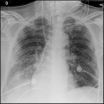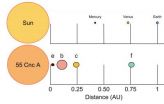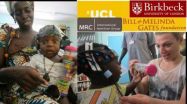(Press-News.org) A new prediction tool can help doctors better identify patients who are at highest risk for respiratory failure after surgery and therefore prevent the often deadly condition, suggest data from a large multi-center study published in the May issue of Anesthesiology.
Affecting nearly 200,000 Americans a year, acute respiratory distress syndrome (ARDS) is a sudden failure of the lungs caused by a number of issues ranging from smoke inhalation to pneumonia or blood infection. High-risk patients can develop ARDS after surgery. ARDS is difficult to treat once it develops and is fatal about 30 percent of the time.
Doctors may be able to take measures during surgery to prevent the condition, such as using blood products conservatively, restricting the volume of fluids administered and using different methods to ventilate the lungs. However, only about 3 percent of patients considered at risk actually develop ARDS and testing preventative measures is costly, time-consuming and may be less than ideal for patients not at high risk. Therefore, researchers in this study focused on identifying patients most likely to develop ARDS after surgery.
"It's certainly true in this case that an ounce of prevention is worth a pound of cure," said Daryl J. Kor, M.D., lead author of the study and associate professor of anesthesiology at Mayo Clinic, Rochester, Minn. "But our ability to predict who is at risk has been limited. By identifying those who are at highest risk with better accuracy, we can begin to take steps toward preventing this dangerous and costly surgical complication."
The prediction tool could help doctors assign risk levels to patients by determining if they have one or more of nine predictors identified as most associated with the development of ARDS: blood infection (sepsis), liver disease, high-risk surgery on the heart or aorta (the body's largest blood vessel), emergency surgery, admission from a location other than home (such as a nursing home or other hospital), an increased respiratory rate, and two measures that show the patient has lower-than-normal oxygen levels in the blood. The more factors that apply to the patient, the greater the risk of developing ARDS, and the more important it is to use preventive measures, Dr. Kor said.
In the study, researchers performed a secondary analysis of data from a trial at 22 medical centers, identifying 1,562 patients who prior to surgery were considered at risk for ARDS – for example, those who had a blood infection or pneumonia. Of those, 117 (7.5 percent) actually developed ARDS. Based on their findings, researchers revised an existing prediction tool (used for ARDS prediction in a patients undergoing elective surgery) so it was far more effective at identifying patients who were at greatest risk for ARDS after a wide variety of surgical procedures.
"Previous efforts have largely focused on treating ARDS well after it's onset," said Dr. Kor. "There has not been a lot of success with that strategy. If the new prediction tool is validated by other studies, it could be used as a screening mechanism to identify patients at greatest risk for ARDS, thereby facilitating it's prevention as well as associated complications and death."
INFORMATION:
The American Society of Anesthesiologists
Founded in 1905, the American Society of Anesthesiologists (ASA) is an educational, research and scientific society with more than 52,000 members organized to raise and maintain the standards of the medical practice of anesthesiology. ASA is committed to ensuring physician anesthesiologists evaluate and supervise the medical care of patients before, during and after surgery to provide the highest quality and safest care every patient deserves.
For more information on the field of anesthesiology, visit the American Society of Anesthesiologists online at asahq.org. To learn more about the role physician anesthesiologists play in ensuring patient safety, visit asahq.org/WhenSecondsCount. Join the social conversation today. Like ASA on Facebook, follow ASALifeline on Twitter.
New tool helps doctors better predict, prevent deadly respiratory failure
2014-04-22
ELSE PRESS RELEASES FROM THIS DATE:
Minnesota projects offer hope and practical help to communities facing more extreme storms
2014-04-22
Recent projects in two Minnesota cities demonstrate how communities can protect themselves from worsening storms. These projects continue a ten year program in New England and the Midwest providing practical and affordable plans tailored to local conditions.
"Our goal is to help communities begin the steps to protect themselves," said program co-leader Latham Stack, of Syntectic International, Portland, OR. "It's important because storms have already worsened. We help communities move beyond feeling paralyzed from the lack of local information and the sense that the problem ...
False-positive mammogram anxiety has limited impact on women's well-being
2014-04-22
(Lebanon, NH, 4/22/14). Dartmouth researchers have found that the anxiety experienced with a false-positive mammogram is temporary and does not negatively impact a woman's overall well-being. Their findings are reported in "Consequences of False-Positive Screening Mammograms," which was published online in the April 21, 2014 JAMA Internal Medicine
Anywhere from 40 to 60 percent of women who undergo routine screening mammography during a ten-year period will experience a false-positive mammogram. Such mammograms require additional testing, sometimes involving a biopsy, ...
Cannabis chemistry: How scientists test pot for potency and safety (video)
2014-04-22
WASHINGTON, April 22, 2014 — Marijuana is in the headlines as more and more states legalize it for medicinal use or decriminalize it entirely. In the American Chemical Society's (ACS') newest Reactions video, we explain the chemistry behind marijuana's high, and investigate what scientists are doing to ensure that legalized weed won't send users on a bad trip. The video is available at http://youtu.be/4ukdUDCE56c
Subscribe to the series at Reactions YouTube, and follow us on Twitter @ACSreactions to be the first to see our latest videos.
INFORMATION:
The American ...
Researchers identify a mechanism linking bariatric surgery to health benefits
2014-04-22
Bariatric surgery has positive effects not only on weight loss but also on diabetes and heart disease. Researchers at the Sahlgrenska Academy and University of Cincinnati have shown that the health benefits are not caused by a reduction in the stomach size but by increased levels of bile acids in the blood. These findings, reported in Nature, indicate that bile acids could be a new target for treating obesity and diabetes.
Previous research from the Sahlgrenska Academy has demonstrated that obesity surgery is the only effective treatment for obesity and obesity-related ...
NeuroPhage discovers GAIM-changing molecules to combat Alzheimer's and related diseases
2014-04-22
Cambridge, MA, April 22, 2014 – Researchers from NeuroPhage Pharmaceuticals, Inc. have engineered a series of molecules with the potential to treat most neurodegenerative diseases that are characterized by misfolded proteins, such as Alzheimer's, Parkinson's and Huntington's diseases. These molecules are based on what the Company calls a general amyloid interaction motif, or GAIM, which recognizes a characteristic common to many toxic, misfolded proteins, not just one type of misfolded protein. This approach provides NeuroPhage with an array of therapeutic targets, so that ...
Sleep disorder linked to brain disease
2014-04-22
Researchers at the University of Toronto say a sleep disorder that causes people to act out their dreams is the best current predictor of brain diseases like Parkinson's and Alzheimer's.
"Rapid-eye-movement sleep behaviour disorder (RBD) is not just a precursor but also a critical warning sign of neurodegeneration that can lead to brain disease," says associate professor and lead author Dr. John Peever. In fact, as many as 80 to 90 per cent of people with RBD will develop a brain disease."
As the name suggests, the disturbance occurs during the rapid-eye-movement (REM) ...
Mysteries of a nearby planetary system's dynamics now are solved
2014-04-22
Mysteries of one of the most fascinating nearby planetary systems now have been solved, report authors of a scientific paper to be published by the journal Monthly Notices of the Royal Astronomical Society in its early online edition on 22 April 2014. The study, which presents the first viable model for the planetary system orbiting one the first stars discovered to have planets -- the star named 55 Cancri -- was led by Penn State University graduate student Benjamin Nelson in collaboration with faculty at the Center for Exoplanets and Habitable Worlds at Penn State and ...
Protein expression gets the heart pumping
2014-04-22
HOUSTON – (April 22, 2014) – Most people think the development of the heart only happens in the womb, however the days and weeks following birth are full of cellular changes that play a role in the structure and function of the heart. Using mouse models, researchers at Baylor College of Medicine have now been able to categorize the alternative splicing (the process in which genes code proteins, determining their role) that takes place during these changes and what mechanisms they affect.
The findings, which appear in Nature Communications, also helped to identify a ...
First brain images of African infants enable research into cognitive effects of nutrition
2014-04-22
Brain activity of babies in developing countries could be monitored from birth to reveal the first signs of cognitive dysfunction, using a new technique piloted by a London-based university collaboration.
The cognitive function of infants can be visualised and tracked more quickly, more accurately and more cheaply using the method, called functional near infra-red spectroscopy (fNIRS), compared to the behavioural assessments Western regions have relied upon for decades.
Professor Clare Elwell, Professor of Medical Physics at University College London (UCL), said: "Brain ...
Scientists discover a new way to enhance nerve growth following injury
2014-04-22
New research published today out of the University of Calgary's Hotchkiss Brain Institute (HBI) uncovers a mechanism to promote growth in damaged nerve cells as a means to restore connections after injury. Dr. Doug Zochodne and his team have discovered a key molecule that directly regulates nerve cell growth in the damaged nervous system. His study was published in the prestigious journal Nature Communications, with lead authors Drs. Kim Christie and Anand Krishnan.
"We made the surprising discovery that a protein called Retinoblastoma (Rb) is present in adult neurons," ...





